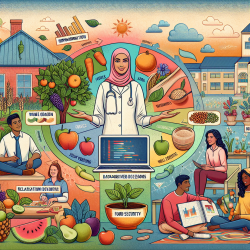Introduction
Food insecurity, defined as the lack of consistent access to enough food for an active, healthy life, is a growing concern among college students. Recent research conducted at a large public university has shown that integrated nutrition and culinary education can significantly improve food security and reduce stress levels among students. This blog will explore how practitioners can leverage these findings to enhance their skills and contribute to better outcomes for children and young adults.
Key Findings from the Research
The study, titled Integrated Nutrition and Culinary Education in Response to Food Insecurity in a Public University, involved a semester-long nutrition course with an integrated teaching kitchen lab. The course aimed to improve students' nutrition knowledge and culinary skills, ultimately enhancing their food security and reducing stress levels. Key findings from the study include:
- An increase in food security from 48% to 70% among participants.
- A decrease in very low food security rates from 23% to 6%.
- A reduction in perceived stress scores from an average of 19.7 to 18.1.
Implementing the Findings in Practice
As a practitioner focused on creating great outcomes for children, integrating nutrition and culinary education into your practice can be highly beneficial. Here are some actionable steps to consider:
1. Develop Comprehensive Nutrition Programs
Create nutrition programs that include both theoretical and practical components. Weekly lectures on basic nutrition concepts can be complemented with hands-on cooking sessions. This approach not only imparts knowledge but also builds essential life skills.
2. Focus on Skill Development
Emphasize skill development in cooking and meal planning. Use affordable and nutritious ingredients to teach students how to prepare balanced meals. This can help them make healthier food choices and improve their overall well-being.
3. Address Food Insecurity Directly
Incorporate discussions about food insecurity and available resources, such as local food banks and assistance programs. Providing this information can empower students to seek help when needed.
4. Foster a Supportive Community
Create a supportive environment where students can share their experiences and learn from each other. This can help reduce the stigma associated with food insecurity and promote a sense of community.
Encouraging Further Research
While the findings from this study are promising, further research is needed to explore the long-term effects of integrated nutrition and culinary education. Practitioners are encouraged to conduct their own studies and share their results with the broader community. This can help build a robust evidence base and drive continuous improvement in practice.
Conclusion
Integrating nutrition and culinary education into your practice can significantly improve food security and reduce stress levels among students. By developing comprehensive programs, focusing on skill development, addressing food insecurity directly, and fostering a supportive community, practitioners can create better outcomes for children and young adults.
To read the original research paper, please follow this link: Integrated Nutrition and Culinary Education in Response to Food Insecurity in a Public University.










